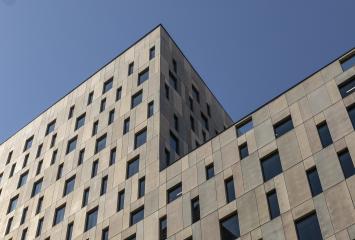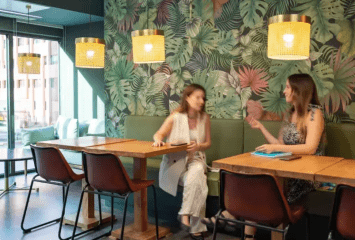The Trends in Office Design to Watch in 2023
The Larkin Administration Building, designed in Buffalo in 1903 by renowned U.S. Architect Frank Lloyd Wright is considered the first modern office building in history. The origin of such workplaces as we know them today. Since then, office design has continuously evolved to meet the new needs arising within companies and allow brands to adapt to prevailing social values. Far from being sluggish, this evolution is happening at maximum speed. New trends emerge each year. These are the trends emerging for 2023:
Pro-Collaborative Approach
There was a time when the priority of office design was to isolate employees. The scientific consensus at that time was that this would promote productivity. Today it is completely the opposite. Companies now prioritize meetings between workers and a collaborative approach to projects. And office design creates the ideal spaces for this.
Symbiosis of the Design with Corporate Identity
Should the design focus on the corporate identity of each company to create personalized spaces? Yes. Should the design, through the choices made, encourage companies to opt for more human-centric and sustainable values? Yes. One of the most distinguishing characteristics of 2023 will be: the symbiosis between the current design philosophy and brand personality.
Embracing Nature
In our article (pending publication) on biophilic design we noted that the use of natural materials, natural light, the inclusion of native plants in indoor vertical gardens or outdoor terraces, the layout of organic patterns, and particularly the pursuit of energy efficiency, are the present and future of office design. The destiny of offices is to be green.
Less is More
Minimalism is not a trend exclusive to 2023. It is a trend in design that has prevailed for years due to its positive effects on human psychology. An excess of furniture and decorative stimuli ultimately generates anxiety and stress, while simplicity produces much more airy spaces with a direct connection to nature.
Open Spaces
This is another trend that emerged in Anglo-Saxon office designs and is also linked to the two previous ones, since it depends in large part on minimalism and satisfies the biophilic needs of the employees at the same time.
Open, airy, bright and green spaces are very reminiscent of certain natural landscapes. People feel free in them.
Multi-Functionality
A company's needs change over time. Even within the same month. Hence there is a rapidly growing use in office design of modular furniture, which can be easily rearranged to create new spaces and meet those needs. Everything is intended to be multi-functional: employees, spaces and organizations.
Folding Furniture
This is another of the most common solutions used in the design of offices to make them more versatile. This type of furniture has two modes: active, when its primary function is available, and inactive, when it increases the amount of free space in a room. An enabler of open spaces. Everything is strategically linked.
Adjustable Desks
Multi-functional desks are a very important part of functional furniture. They bring a very significant added benefit: Their height can be adjusted so that different employees can use them without tilting their heads excessively or putting too much stress on their neck muscles. Their use is consistent with the human-centric approach we promote at Colonial.
Color Blocking
Eliminating sensory overload increases the well being of employees and boosts their productivity. However, a lack of stimuli can also have negative consequences. Hence the current trend to create micro-spaces that are clearly differentiated by the use of colors. It gives them personality. It helps employees associate different spaces with specific functions.
Pendant Lights
Over the past decade, it has become a priority in office design to create well-lit spaces without excessively contributing to global warming. And there are some types of pendant lights that are excellent for dark spaces where a high level of concentration is required. In this case, sustainable LED bulbs are always used.
Smart Technologies
Offices are physical spaces that are increasingly becoming part of the digital universe. In this regard, professional designers are including both futuristic decorations as well as smart solutions based on home automation. They are also including integrative designs to make the most of the main electronic devices such as computers, tablets or smartphones.

